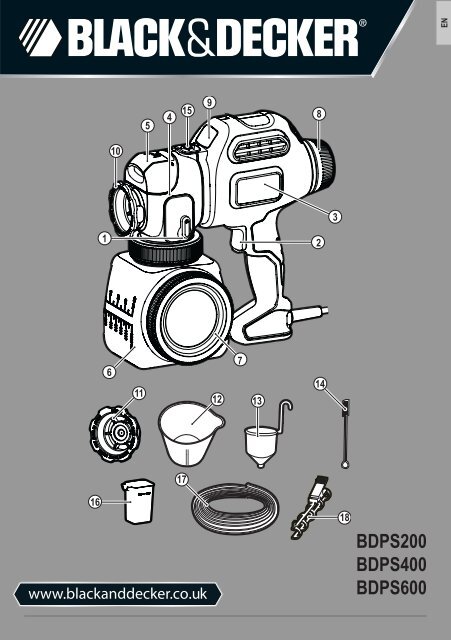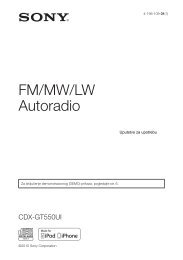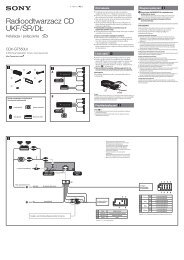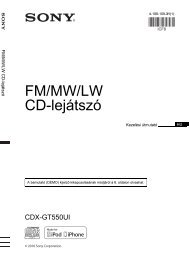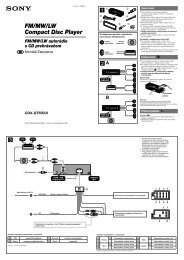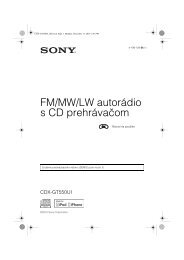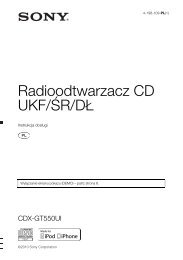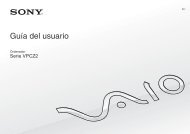BlackandDecker Pistolet A Peindre- Bdps200 - Type 1 - Instruction Manual (Anglaise)
BlackandDecker Pistolet A Peindre- Bdps200 - Type 1 - Instruction Manual (Anglaise)
BlackandDecker Pistolet A Peindre- Bdps200 - Type 1 - Instruction Manual (Anglaise)
You also want an ePaper? Increase the reach of your titles
YUMPU automatically turns print PDFs into web optimized ePapers that Google loves.
BDPS200<br />
BDPS400<br />
BDPS600
A<br />
B1<br />
B2<br />
C<br />
D<br />
E<br />
2
F<br />
G<br />
H<br />
I<br />
J<br />
K<br />
3
L<br />
M<br />
N<br />
O<br />
1<br />
2<br />
P<br />
Q<br />
4
R<br />
S<br />
T<br />
U<br />
V<br />
W<br />
5
X<br />
Y<br />
Z<br />
6
(Original instructions)<br />
ENGLISH<br />
Intended use<br />
Your Black & Decker floor based fine spray system is<br />
intended for atomising solvent based and water based paints,<br />
finishes, primers, clear finishes, automotive finishes, staining<br />
sealers, wood sealer-preservatives. The power tool is not<br />
suitable for spraying caustic solutions, acidic coating<br />
materials, coating materials with granules or solids as well as<br />
spray and drip-impeding materials.. This appliance is intended<br />
for consumer use only.<br />
Safety instructions<br />
General power tool safety warnings<br />
@<br />
Warning! Read all safety warnings and all<br />
instructions. Failure to follow the warnings and<br />
instructions listed below may result in electric<br />
shock, fire and/or serious injury.<br />
Save all warnings and instructions for future reference.<br />
The term "power tool" in all of the warnings listed below refers<br />
to your mains operated (corded) power tool or battery operated<br />
(cordless) power tool.<br />
1. Work area safety<br />
a. Keep work area clean and well lit. Cluttered or dark<br />
areas invite accidents.<br />
b. Do not operate power tools in explosive atmospheres,<br />
such as in the presence of flammable liquids, gases<br />
or dust. Power tools create sparks which may ignite the<br />
dust or fumes.<br />
c. Keep children and bystanders away while operating a<br />
power tool. Distractions can cause you to lose control.<br />
2. Electrical safety<br />
a. Power tool plugs must match the outlet. Never modify<br />
the plug in any way. Do not use any adapter plugs<br />
with earthed (grounded) power tools. Unmodified plugs<br />
and matching outlets will reduce risk of electric shock.<br />
b. Avoid body contact with earthed or grounded<br />
surfaces such as pipes, radiators, ranges and<br />
refrigerators. There is an increased risk of electric shock<br />
if your body is earthed or grounded.<br />
c. Do not expose power tools to rain or wet conditions.<br />
Water entering a power tool will increase the risk of<br />
electric shock.<br />
d. Do not abuse the cord. Never use the cord for<br />
carrying, pulling or unplugging the power tool. Keep<br />
cord away from heat, oil, sharp edges or moving<br />
parts. Damaged or entangled cords increase the risk of<br />
electric shock.<br />
e. When operating a power tool outdoors, use an<br />
extension cord suitable for outdoor use. Use of a cord<br />
suitable for outdoor use reduces the risk of electric shock.<br />
f. If operating a power tool in a damp location is<br />
unavoidable, use a residual current device (RCD)<br />
protected supply. Use of an RCD reduces the risk of<br />
electric shock.<br />
3. Personal safety<br />
a. Stay alert, watch what you are doing and use common<br />
sense when operating a power tool. Do not use a<br />
power tool while you are tired or under the influence<br />
of drugs, alcohol or medication. A moment of inattention<br />
while operating power tools may result in serious personal<br />
injury.<br />
b. Use personal protective equipment. Always wear eye<br />
protection. Protective equipment such as dust mask,<br />
non-skid safety shoes, hard hat, or hearing protection<br />
used for appropriate conditions will reduce personal<br />
injuries.<br />
c. Prevent unintentional starting. Ensure the switch is in<br />
the off-position before connecting to power source<br />
and/or battery pack, picking up or carrying the tool.<br />
Carrying power tools with your finger on the switch or<br />
energising power tools that have the switch on invites<br />
accidents.<br />
d. Remove any adjusting key or wrench before turning<br />
the power tool on. A wrench or a key left attached to a<br />
rotating part of the power tool may result in personal injury.<br />
e. Do not overreach. Keep proper footing and balance at<br />
all times. This enables better control of the power tool in<br />
unexpected situations.<br />
f. Dress properly. Do not wear loose clothing or<br />
jewellery. Keep your hair, clothing and gloves away<br />
from moving parts. Loose clothes, jewellery or long hair<br />
can be caught in moving parts.<br />
g. If devices are provided for the connection of dust<br />
extraction and collection facilities, ensure these are<br />
connected and properly used. Use of dust collection can<br />
reduce dust-related hazards.<br />
4. Power tool use and care<br />
a. Do not force the power tool. Use the correct power<br />
tool for your application. The correct power tool will do<br />
the job better and safer at the rate for which it was<br />
designed.<br />
b. Do not use the power tool if the switch does not turn it<br />
on and off. Any power tool that cannot be controlled with<br />
the switch is dangerous and must be repaired.<br />
7
ENGLISH<br />
(Original instructions)<br />
c. Disconnect the plug from the power source and/or the<br />
battery pack from the power tool before making any<br />
adjustments, changing accessories, or storing power<br />
tools. Such preventive safety measures reduce the risk of<br />
starting the power tool accidentally.<br />
d. Store idle power tools out of the reach of children and<br />
do not allow persons unfamiliar with the power tool or<br />
these instructions to operate the power tool. Power<br />
tools are dangerous in the hands of untrained users.<br />
e. Maintain power tools. Check for misalignment or<br />
binding of moving parts, breakage of parts and any<br />
other condition that may affect the power tools<br />
operation. If damaged, have the power tool repaired<br />
before use. Many accidents are caused by poorly<br />
maintained power tools.<br />
f. Keep cutting tools sharp and clean. Properly<br />
maintained cutting tools with sharp cutting edges are less<br />
likely to bind and are easier to control.<br />
g. Use the power tool, accessories and tool bits etc. in<br />
accordance with these instructions, taking into<br />
account the working conditions and the work to be<br />
performed. Use of the power tool for operations different<br />
from those intended could result in a hazardous situation.<br />
5. Service<br />
a. Have your power tool serviced by a qualified repair<br />
person using only identical replacement parts. This<br />
will ensure that the safety of the power tool is maintained.<br />
Additional safety instructions<br />
Warning!<br />
u Read all instructions and safety precautions for equipment<br />
and spray material before operation any equipment.<br />
u Comply with all appropriate local, state and national codes<br />
governing ventilation, fire prevention and operation.<br />
u Keep sprayer out of reach of children.<br />
u Hearing protection is recommended for extended use.<br />
u Use eye protection to keep particles out of eyes.<br />
Hazardous vapours<br />
Insecticides and other materials may be harmful if inhaled<br />
causing severe nausea, fainting or poisoning.<br />
a. Use a respirator or mask whenever there is a chance<br />
that vapours may be inhaled. Read all instructions<br />
with the spray material and mask to ensure that it will<br />
provide the necessary protection against the<br />
inhalation of harmful vapours.<br />
Additional safety instructions for paint sprayers<br />
Warning!<br />
u Before any use, be sure anyone using this sprayer reads<br />
and understands all safety instructions and other information<br />
contained in this manual.<br />
8<br />
u Do not use caustic (alkali) self heating or corrosive (acid)<br />
liquids in this sprayer as these can corrode metal parts or<br />
weaken hose and seals.<br />
u Do not use hot or boiling liquids in sprayer as this may<br />
weaken tank and hose.<br />
u Do not leave residue or spray material in the tank after<br />
using sprayer.<br />
u Do not smoke while spraying or spray where spark of<br />
flame is present.<br />
u Do thoroughly inspect both inside and outside of sprayer<br />
before each use.<br />
u Do empty, clean and drain both tank and hose after each<br />
use according to directions.<br />
u Do not use guns for spraying flammable materials.<br />
u Do not spray any material where the hazard is not known.<br />
u Use only non-flammable liquids.<br />
u Do not clean guns with flammable materials.<br />
Personal safety<br />
a. Additional personal safety equipment such as<br />
appropriate gloves and a respirator or mask must be<br />
used when handling chemicals. Safety equipment used<br />
for appropriate conditions will reduce personal injuries.<br />
b. Do not spray yourself, any person or animal. Keep<br />
hands and other body parts away from the discharge.<br />
In case of skin injection, seek medical attention<br />
immediately. The sprayed material may pierce the skin<br />
and be injected to your body.<br />
c. Do not treat injection as a simple cut. Spray is able to<br />
inject toxins into the body and cause serious bodily injury.<br />
In the event that injection occurs, seek medical attention<br />
immediately.<br />
d. Beware of any hazards presented by the material<br />
being sprayed. Consult the markings on the container<br />
or the information supplied by the manufacturer of the<br />
material to be sprayed, including requirements for the<br />
use of personal protective equipment. Manufacturer's<br />
instructions must be followed to reduce the risk of fire and<br />
personal injury, derived from toxins, carcinogens, etc.<br />
Safety of others<br />
u This appliance is not intended for use by persons (including<br />
children) with reduced physical, sensory or mental<br />
capabilities, or lack of experience and knowledge, unless<br />
they have been given supervision or instruction concerning<br />
the use of the appliance by a person responsible for<br />
their safety.<br />
u Children should be supervised to ensure that they do not<br />
play with the appliance.
(Original instructions)<br />
ENGLISH<br />
Residual risks.<br />
Additional residual risks may arise when using the tool which<br />
may not be included in the enclosed safety warnings. These<br />
risks can arise from misuse, prolonged use etc.<br />
Even with the application of the relevant safety regulations<br />
and the implementation of safety devices, certain residual<br />
risks can not be avoided. These include:<br />
u Injuries caused by touching any moving parts.<br />
u Injuries caused by touching any hot parts.<br />
u Injuries caused when changing any parts or accessories.<br />
u Injuries caused by prolonged use of the appliance. When<br />
using any appliance for prolonged periods ensure you<br />
take regular breaks.<br />
Vibration<br />
The declared vibration emission values stated in the technical<br />
data and the declaration of conformity have been measured<br />
in accordance with a standard test method provided by<br />
EN 60745 and may be used for comparing one tool with<br />
another. The declared vibration emission value may also be<br />
used in a preliminary assessment of exposure.<br />
Warning! The vibration emission value during actual use of<br />
the power tool can differ from the declared value depending<br />
on the ways in which the tool is used. The vibration level may<br />
increase above the level stated.<br />
When assessing vibration exposure to determine safety<br />
measures required by 2002/44/EC to protect persons regularly<br />
using power tools in employment, an estimation of vibration<br />
exposure should consider, the actual conditions of use and the<br />
way the tool is used, including taking account of all parts of the<br />
operating cycle such as the times when the tool is switched off<br />
and when it is running idle in addition to the trigger time.<br />
Labels on the appliance<br />
The following pictograms are shown on the tool:<br />
:<br />
R<br />
Warning! To reduce the risk of injury, the user<br />
must read the instruction manual.<br />
Warning! Do not expose the appliance to rain or<br />
high humidity.<br />
Warning! Keep bystanders away.<br />
6<br />
&<br />
Electrical safety<br />
@<br />
Warning! Wear a respirator or mask.<br />
Warning! Use only non-flammable liquids.<br />
Warning! This product must be earthed.<br />
Always check that the power supply corresponds<br />
to the voltage on the rating plate.<br />
Power plugs must match the outlet. Never modify the plug in<br />
any way. Unmodified plugs and matching outlets will reduce<br />
risk of electric shock.<br />
u If the supply cord is damaged, it must be replaced by<br />
the manufacturer or an authorised Black & Decker<br />
Service Centre in order to avoid a hazard.<br />
Extension cables & Class 1 product<br />
u A 3-core cable must be used as your appliance is<br />
earthed and of Class 1 construction.<br />
u Up to 30m (100 ft) can be used without loss of power.<br />
u Electric safety can be further improved by using a highsensitivity<br />
30 mA residual current device (RCD).<br />
Features<br />
This appliance includes some or all of the following features.<br />
1. Quick clean lever<br />
2. Spray trigger<br />
3. Sprayer<br />
4. Power unit<br />
5. Quick clean door<br />
6. Side fill canister<br />
7. Lid<br />
8. Flow control knob<br />
9. Speed control switch<br />
10. Green fan spray nozzle (BDPS400 & BDPS600 only)<br />
11. Blue cone nozzle<br />
12. Mixing bucket (BDPS600 only)<br />
13. Viscosity cup<br />
14. Cleaning bush<br />
15. Sprayer release button<br />
16. Quick clean fill cup (BDSP600 only)<br />
17. Paint can clip (BDSP600 only)<br />
18. Direct to tin hose (BDSP600 only)<br />
O<br />
Warning! Wear safety glasses or goggles when<br />
operating this tool.<br />
9
ENGLISH<br />
(Original instructions)<br />
Assembly<br />
Warning! Before assembly, make sure that the tool is<br />
switched off and unplugged.<br />
Attaching the side fill canister (fig. A)<br />
The side fill canister is designed so it will only fit one way<br />
round.<br />
u Align the side fill canister (6) below the pick up tube (19)<br />
with the lid (7) to the left.<br />
u Push the side fill canister (6) firmly into place.<br />
u Tighten the locking ring (20) by turning it clockwise.<br />
Note: Ensure that the locking ring is tight and that the side fill<br />
canister is firmly secured in place.<br />
Aligning the pickup tube (fig. B1 & B2)<br />
The pickup tube can be aligned in the direction that you will be<br />
doing the most spraying to help minimize the amount of times<br />
that you will have to refill the canister.<br />
u If you are spraying at an upward angle or straight on,<br />
position the pickup tube (fig. B) toward the back of the<br />
canister.<br />
u If you are spraying at a downward angle, position the<br />
pickup tube (fig. C) toward the front of the canister.<br />
This will ensure you spray as much material as possible<br />
before you need to refill.<br />
Attaching and removing the spray nozzels (fig. C<br />
& D)<br />
To attach the green fan spray nozzle: (Where supplied)<br />
u Turn the nozzle (10) clockwise onto the spindle for 6 - 8<br />
full turns.<br />
u Push in the nozzle (10) and continue to turn it clockwise<br />
untill it is fully seated.<br />
Note: Ensure the spray nozzle is completely threaded on by<br />
hand only. If it is not fully seated in can leak or damage the<br />
nozzle.<br />
To remove the green fan spray nozzle: (Where supplied)<br />
u Push in the nozzle (10) and turn it anticlockwise.<br />
To attach the blue cone spray nozzle:<br />
u Turn the nozzle (11) clockwise onto the spindle until it is<br />
fully seated.<br />
Note: Ensure the spray nozzle is completely threaded on by<br />
hand only. If it is not fully seated in can leak or damage the<br />
nozzle.<br />
To remove the blue cone spray nozzle:<br />
u Turn the nozzle (11) anticlockwise.<br />
Filling the canister (fig. E<br />
u Check to make sure that the side fill canister (6) is completely<br />
screwed onto the sprayer.<br />
u Lay the sprayer on its side with the canister side lid facing<br />
up.<br />
u Pour the properly thinned and strained material to be<br />
sprayed into the side fill canister.<br />
Note : Use a mixing bucket to pour material from the original<br />
material container into the side fill canister.<br />
u Clean any residual liquid from the threads or sides of the<br />
canister and sprayer.<br />
u Starting the threads evenly, screw the lid completely<br />
onto the side fill canister. Check the lid to make sure it is<br />
threaded on squarely and completely before picking up<br />
the sprayer.<br />
Use<br />
Switching on and off<br />
The sprayer is turned on and off with the spray trigger.<br />
u To turn the sprayer on, squeeze the spray trigger (2).<br />
u To turn the sprayer off, release the spray trigger (2).<br />
Warning! Never point the sprayer at any part of the body.<br />
Never pull the trigger while adjusting the spray setting.<br />
Selecting the spray pattern (fig. F & G) (BDPS400 &<br />
BDPS600 Only<br />
This sprayer is supplied with 2 nozzles which are capable of<br />
producing 3 spray patterns. .<br />
Green nozzle - Horizontal Flat Jet - Apply up and down<br />
a surface.<br />
Green nozzle - Vertical Flat Jet - Apply side to side.<br />
Blue nozzle - Circular Jet - for corners, edges and narrow<br />
surfaces.<br />
u To select the cone spray pattern, fit the blue cone nozzle.<br />
u To select the horizontal fan spray pattern, fit the green fan<br />
spray nozzle and turn the nozzle so so the jet indicator<br />
tabs (21) are in the vertical position (fig. F).<br />
u To select the Vertical fan spray pattern, fit the green fan<br />
spray nozzle and turn the nozzle so so the jet indicator<br />
tabs (21) are in the horizontal position (fig. G).<br />
Warning! Never point the sprayer at any part of the body.<br />
Never pull the trigger while adjusting the spray setting.<br />
10
(Original instructions)<br />
ENGLISH<br />
Two speed control switch (fig. H) (BDPS600 only)<br />
Your sprayer has two different speed settings.<br />
u To change speeds, press the speed control switch (9). An<br />
LED indicates setting 1 or 2.<br />
u Set the flow control knob (8) to a lower or medium settting<br />
(1-5) when on speed setting 1.<br />
u Set the flow control knob (8) to medium or higher setting<br />
(5-9) when on speed setting 2.<br />
Use the lower speed setting (Setting 1) to obtain greater control<br />
over your spraying project, while the higher speed (Setting<br />
2) allows for greater coverage in a shorter amount of time.<br />
The lower speed level allows you to get closer to your work<br />
with less overspray. Low setting works well with lighter bodied<br />
or more free flowing paints like stains and sealers.<br />
More heavy bodied paints, like water based latex, will need<br />
setting number 2<br />
Use the speed control setting in conjuction with the flow<br />
control knob and test for what works best with your material<br />
being sprayed.<br />
Flow control knob (fig. I)<br />
The flow control knob regulates the amount of liquid that can<br />
be sprayed.<br />
u Turn the flow control knob (8) clockwise to increase the<br />
flow of liquid<br />
u Turn the flow control knob (8) counterclockwise to<br />
decrease the flow of liquid.<br />
Note : Always test the spray pattern on scrap cardboard<br />
or similar material first. Begin with flow control knob on the<br />
highest flow setting. If less flow is desired, dial the flow control<br />
knob in. Heavier, thicker materials should be sprayed with the<br />
higher settings 7 - 9. Thinner materials should be sprayed with<br />
the lower settings 1 -3.<br />
Note : If the flow control setting is set completely to the<br />
minimum side, the trigger will have limited or no travel. Back<br />
the flow control knob off (clockwise) to allow for more trigger<br />
travel.<br />
Direct to tin hose (fig. J & K) (BDPS600 only)<br />
It is possible to use the BDPS600 with out the side fill canister.<br />
When using the supplied 'direct to tin hose' you can take the<br />
paint supply directly from the paint tin.<br />
u Remove the sidefill canister (6), pickup tube (19) and filter<br />
(25).<br />
u Push the suction hose onto the intake (30) and return (29)<br />
ports.<br />
u Pull the hose apart on the opposite end and slide the<br />
larger hose (17) completely through the container clip<br />
(18), then over the barbs (22) of the pickup tube (19).<br />
u Place the suction tube assembly into the material container<br />
and attach the container clip securely to the side.<br />
Check to make sure that complete assembly is submerged<br />
in the material container.<br />
Liquid material preparation (fig. L & M)<br />
Note : Make sure the type of material you use can be cleaned<br />
with either mineral spirits or paint thinner (for oil-based paints)<br />
or a warm water and soap solution (for water soluble paints<br />
like latex). Use drop cloths to protect your floors and anything<br />
else in the spraying area that you wish to remain untouched.<br />
The liquid being sprayed may need to be thinned (diluted)<br />
before staring. When thinning, use the proper liquid thinner<br />
recommended on the container by the material manufacturer.<br />
Warning! Do not use materials with a flashpoint lower than<br />
55°C.<br />
Note : A mixing bucket (12) is provided (BDPS600 only)to use<br />
when transferring spray material from the original container<br />
into the bucket for thinning and measuring purposes (fig. L).<br />
Note : A viscosity cup (13) is provided to determine the<br />
“runout time” of the material being used.<br />
u Before measuring for the proper viscosity, stir the material<br />
thoroughly.<br />
u Dip the viscosity cup (13) into the material being sprayed<br />
and fill the viscosity cup (13) completely.<br />
u With the viscosity cup (13) held over the material container,<br />
measure the amount of time it takes for the stream<br />
of material flowing out to “break” or stop being a constant<br />
stream out of the bottom of the viscosity cup (13) (2<br />
minutes or less) (fig. M). This is the “runout time” Refer to<br />
the thinning table for information on the thinning required<br />
for different materials.<br />
u If material needs thinning, add the appropriate liquid thinning<br />
material recommended by the manufacturer.<br />
u It is possible to spray latex paint with this unit, however<br />
the paint may require thinning. In some cases the paint<br />
may require thinning beyond the paint manufacturers<br />
recommendations, please consult the paint manufacturers<br />
instructions. If a paint is found to be too thick and will not<br />
spray, thin the paint using the appropriate thinning material.<br />
Thinning material should be added at a ratio of 5% of<br />
the volume of paint until the paint flows through the paint<br />
gun providing an even and satisfactory finish.<br />
Thinning table<br />
Spray material<br />
Clear and semi-transparent stains<br />
and sealers<br />
Oil based primers, varnishes and<br />
polyurethane<br />
Solid colour water based stains<br />
Water based or latex paints<br />
Runout time<br />
No thinning required<br />
(Less than 2 minute runout)<br />
May require thinning<br />
(More than 2 minute runout)<br />
Note : Not recommended for textured paint<br />
11
ENGLISH<br />
(Original instructions)<br />
Hints for optimum use<br />
Preparation tips<br />
u Always stir and strain the material thoroughly before use.<br />
u With any spraying job you should always ensure that<br />
you have properly prepared the surface to get the best<br />
finish. That is, all surfaces are free from dust, dirt, rust and<br />
grease. Lightly pressure wash decks or exterior surfaces<br />
and ensure that they are dry before spraying.<br />
u It is recommended that you mask all edges and other<br />
areas and use drop cloths to protect your floors and<br />
anything else in the spraying area that you wish to remain<br />
untouched.<br />
u Skin that forms on the top of paint can clog the sprayer.<br />
Remove skin before mixing. Strain with a funnel with a<br />
filter attached or through hosiery to remove any impurities<br />
that could clog system.<br />
u Before starting have gloves, paper towels, rags etc. available<br />
for unexpected spills.<br />
Developing the proper spraying technique (fig. N & O)<br />
u Practice spraying on a piece of scrap material such as<br />
cardboard to test your spray pattern and become familiar<br />
with the flow control feature of the sprayer.<br />
u Ensure surface to be sprayed is free of dust, dirt, and<br />
grease.<br />
u Ensure spray area is clean and free of dust that could be<br />
blown onto newly sprayed surfaces.<br />
u Cover any areas not intended to be sprayed.<br />
u Always spray from a minimum of 25mm to a maximum of<br />
355mm (fig. N).<br />
u A commonly used method for spraying a large surface<br />
is the “crisscross” pattern. This is done by spraying in<br />
horizontal strips and then crossing over these strips with<br />
vertical strips.<br />
u To get an even spray distribution, always keep your arm at<br />
the same distance (fig. N) from the surface you are spraying<br />
and avoid moving your wrist (fig. O).<br />
u Maintain smooth and consistent speed which will help<br />
avoid inconsistencies. Begin spraying after the pass has<br />
begun and release trigger before stopping the pass.<br />
u Avoid spraying too heavily in any one area. Several lighter<br />
coats are better than one heavy coat which can lead to<br />
running and dripping. Remember that the flow control<br />
knob regulates the amount of liquid that can be sprayed.<br />
Turning the flow knob clockwise increases the flow of<br />
liquid. Turning the knob counterclockwise decreases the<br />
flow of liquid. If runs or drips do occur, have a dry paint<br />
brush on hand to smooth them out.<br />
u Turn the power unit off and place the sprayer in the built-in<br />
dock of the power unit when not spraying for any length of<br />
time.<br />
Maintenance and cleaning<br />
Your Black & Decker corded appliance has been designed to<br />
operate over a long period of time with a minimum of maintenance.<br />
Continuous satisfactory operation depends upon<br />
proper appliance care and regular cleaning.<br />
Warning! Be sure to use appropriate personal protective<br />
equipment.<br />
Warning! Before performing any maintenance or cleaning on<br />
corded appliances switch off and unplug the appliance.<br />
Warning! Do not use materials with a flashpoint lower than<br />
55°C. Flashpoint is the temperature that a fluid can produce<br />
enough vapours to ignite (see paint supplier instructions).<br />
Warning! Make sure clean up area is well ventilated and free<br />
of flammable vapours.<br />
Warning! Always spray outdoors when spraying cleaning<br />
solution through sprayer.<br />
Warning! Do not submerse power unit.<br />
Using the quick clean system (fig. P & Q) (BDPS400<br />
& BDPS600 only)<br />
The quick clean system allows for a variety of useful functions.<br />
First, the system can allow you to spray water or a suitable<br />
cleaning liquid while there is still spray material in the main<br />
canister. This is useful when setting up your spray pattern with<br />
the fan nozzle. You can spray water instead of wasting spray<br />
material to view the spray pattern.<br />
Second, the quick clean system allows you to flush the pump<br />
assembly, the piston, the nozzle and the atomizer valve. When<br />
spraying for long periods of time, spray material may build<br />
up causing a deterioration of the spray quality. It is good to<br />
flush this system with water or cleaning liquid after every other<br />
spray material refill. It is also important to flush the system<br />
when the sprayer will sit for more than 15 minutes without use.<br />
Spray material can dry on the nozzle and pump assembly and<br />
would require a thorough cleaning. Always oil piston if sitting<br />
idle for a long period of time. See “Reassembly Section”.<br />
Third, the quick clean system allows for a faster clean-up<br />
when your project is complete. One or two flushes through<br />
the quick clean system gives you a head start on cleaning<br />
the nozzle, the atomizer, the pump and piston. Please follow<br />
recommended cleaning steps in this manual when performing<br />
a final clean of the system.<br />
u Disconnect the sprayer from the power supply.<br />
u Open the quick clean door (5), and pour in the cleaning<br />
solution using the quick clean fill cup (16).<br />
Warning! Do not overfill the reservoir.<br />
u Switch the quick clean lever (1) from paint to clean.<br />
u Spray into a waste container, cardboard box or test<br />
surface to completely flush the sprayer system.<br />
u Repeat until the cleaning solution has returned to its<br />
natural colour.<br />
12
(Original instructions)<br />
ENGLISH<br />
Flushing the sprayer (fig. Q & R)<br />
u Disconnect the sprayer from the power supply.<br />
u Unscrew the lid from the side of the canister and pour any<br />
remaining liquid back into the original container (fig. R).<br />
u Pour a small amount of the appropriate cleaning solution<br />
into the canister.<br />
t Warm soapy water for water based materials.<br />
t Manufacturers recommended cleaning solution for oil<br />
based materials.<br />
u Replace the lid (7) on the canister (6) securely and vigorously<br />
shake the sprayer.<br />
u Unscrew the lid (7) from the side of the canister and<br />
properly dispose of cleaning solution.<br />
u Refill the canister with a small amount of new cleaning<br />
solution. Screw lid securely on canister.<br />
u Reattach the sprayer to the motor unit, plug in the cord<br />
and turn on the power unit.<br />
u Switch the quick clean lever (1) from clean to paint. (fig.Q)<br />
u Spray the cleaning solution through the sprayer onto scrap<br />
material for 5 seconds.<br />
Cleaning the sprayer (fig. S - X)<br />
u Disconnect the sprayer from the power supply.<br />
u Remove the side fill canister (6) and unscrew the side lid<br />
(7). Remove the pickup tube (19) and o-ring (23) from the<br />
sprayer. Clean the parts with the cleaning brush (14) in the<br />
appropriate cleaning solution (fig. S).<br />
u Remove the front housing of the sprayer, by pressing<br />
down on the release button (15) and pulling the front<br />
housing off of the sprayer (fig. T).<br />
u Remove the piston (27) and spring (26) (fig. U).<br />
u Remove the spray nozzle (10 / 11), by turning counterclockwise,<br />
then remove the atomizer (24) (fig. U).<br />
u Clean the spray nozzle (10 / 11), pickup tube (19) and filter<br />
(25), atomizer (24), piston (27) and spring (26) with the<br />
cleaning brush (14) in the appropriate cleaning solution<br />
(fig. T).<br />
u Thoroughly clean the inside of the piston chamber (28)<br />
with the cleaning brush (14) (fig. V)<br />
Important : Be sure to remove all material from inside<br />
of piston chamber. A small amount of material that is not<br />
removed with the cleaning brush can harden over time and<br />
interfere with the movement of the piston causing damage to<br />
the sprayer.<br />
u Switch the quick clean lever (1) from clean to paint.<br />
u Thoroughly clean the inside of the intake (30) and return<br />
(29) openings with the cleaning brush (fig. W).<br />
Important : Thoroughly clean the smaller vent hole (31), with<br />
a pin or paper clip (fig. X).<br />
u Dry all parts thoroughly.<br />
u Properly dispose of cleaning solution.<br />
u Reassemble sprayer.<br />
Reassembling the sprayer (fig. Y & Z)<br />
u Slide the spring (26) onto the front of the piston (27).<br />
u Insert the piston and spring into the front housing.<br />
u Pressing down on the release button (15), insert the front<br />
housing with piston, into the sprayer until the release button<br />
pops into place.<br />
u Place a few drops of oil through the cylinder opening. Insert<br />
the atomizer valve (24) into the front housing. Thread<br />
the spray nozzle (10 / 11) onto the front housing and hand<br />
tighten.<br />
u Using the oil lubricant provided, place a few drops of<br />
oil down the intake (30) and return (29) openings of the<br />
sprayer.<br />
u Rotate the quick clean lever (1) from paint to clean and<br />
back 3 times after oiling.<br />
u Insert the pickup tube (19) into the intake opening (30) on<br />
the sprayer.<br />
u Re-fit the side fill canister.<br />
Cleaning the power unit<br />
u Turn the power unit off, unplug the cord and disconnect<br />
the sprayer from the motor unit.<br />
u Use only mild soap and damp cloth to clean the power<br />
unit.<br />
Warning! Never let any liquid get inside the power unit.<br />
Warning! Never immerse any part of the power unit into a<br />
liquid.<br />
Mains plug replacement (U.K. & Ireland only)<br />
If a new mains plug needs to be fitted:<br />
u Safely dispose of the old plug.<br />
u Connect the brown lead to the live terminal in the new<br />
plug.<br />
u Connect the blue lead to the neutral terminal.<br />
u Connect the green/yellow lead to the earth terminal.<br />
Warning! Follow the fitting instructions supplied with good<br />
quality plugs. Recommended fuse: 13A.<br />
Protecting the environment<br />
Z<br />
Separate collection. This product must not be<br />
disposed of with normal household waste.<br />
Should you find one day that your Black & Decker product<br />
needs replacement, or if it is of no further use to you, do not<br />
dispose of it with household waste. Make this product available<br />
for separate collection.<br />
z<br />
Separate collection of used products and packaging<br />
allows materials to be recycled and used again.<br />
Re-use of recycled materials helps prevent environmental<br />
pollution and reduces the demand for raw<br />
materials.<br />
13
ENGLISH<br />
(Original instructions)<br />
Local regulations may provide for separate collection of electrical<br />
products from the household, at municipal waste sites or<br />
by the retailer when you purchase a new product.<br />
Black & Decker provides a facility for the collection and<br />
recycling of Black & Decker products once they have reached<br />
the end of their working life. To take advantage of this service<br />
please return your product to any authorised repair agent who<br />
will collect them on our behalf.<br />
You can check the location of your nearest authorised repair<br />
agent by contacting your local Black & Decker office at<br />
the address indicated in this manual. Alternatively, a list of<br />
authorised Black & Decker repair agents and full details of our<br />
after-sales service and contacts are available on the Internet<br />
at: www.2helpU.com<br />
Technical data<br />
EC declaration of conformity<br />
MACHINERY DIRECTIVE<br />
%<br />
BDPS200, BDPS400, BDPS600<br />
Black & Decker declares that these products described under<br />
"technical data" are in compliance with:<br />
2006/42/EC, EN60745<br />
For more information, please contact Black & Decker at the<br />
following address or refer to the back of the manual.<br />
The undersigned is responsible for compilation of the technical<br />
file and makes this declaration on behalf of Black & Decker.<br />
BDPS200<br />
(<strong>Type</strong> 1)<br />
BDPS400<br />
(<strong>Type</strong> 1)<br />
BDPS600<br />
(<strong>Type</strong> 1)<br />
Voltage V ac 230 230 230<br />
Power<br />
W<br />
120 150 150<br />
Tank capacity<br />
l<br />
1.2 1.2 1.2<br />
Weight kg 2.1 2.2 2.2<br />
_<br />
Kevin Hewitt<br />
Vice-President Global Engineering<br />
Black & Decker Europe, 210 Bath Road, Slough,<br />
Berkshire, SL1 3YD<br />
United Kingdom<br />
28/09/2011<br />
Level of sound pressure according to EN 60745:<br />
Sound pressure (L pA<br />
) 90 dB(A), uncertainty (K) 3 dB(A)<br />
Sound power (L WA<br />
) 103 dB(A), uncertainty (K) 3 dB(A)<br />
Vibration total values (triax vector sum) according to EN 60745:<br />
Vibration emission value (a h, D<br />
) 11 m/s 2 , uncertainty (K) 1.5 m/s 2<br />
14
Guarantee<br />
Black & Decker is confident of the quality of its products and<br />
offers an outstanding guarantee. This guarantee statement is<br />
in addition to and in no way prejudices your statutory rights.<br />
The guarantee is valid within the territories of the Member<br />
States of the European Union and the European Free Trade<br />
Area.<br />
If a Black & Decker product becomes defective due to faulty<br />
materials, workmanship or lack of conformity, within 24<br />
months from the date of purchase, Black & Decker guarantees<br />
to replace defective parts, repair products subjected to fair<br />
wear and tear or replace such products to ensure minimum<br />
inconvenience to the customer unless:<br />
u The product has been used for trade, professional or hire<br />
purposes;<br />
u The product has been subjected to misuse or neglect;<br />
u The product has sustained damage through foreign<br />
objects, substances or accidents;<br />
u Repairs have been attempted by persons other than<br />
authorised repair agents or Black & Decker service staff.<br />
To claim on the guarantee, you will need to submit proof of<br />
purchase to the seller or an authorised repair agent. You can<br />
check the location of your nearest authorised repair agent<br />
by contacting your local Black & Decker office at the address<br />
indicated in this manual. Alternatively, a list of authorised<br />
Black & Decker repair agents and full details of our aftersales<br />
service and contacts are available on the Internet at:<br />
www.2helpU.com<br />
Please visit our website www.blackanddecker.co.uk to register<br />
your new Black & Decker product and to be kept up to date<br />
on new products and special offers. Further information on the<br />
Black & Decker brand and our range of products is available<br />
at www.blackanddecker.co.uk<br />
15
25<br />
65<br />
33<br />
E16491<br />
63<br />
31<br />
32<br />
60<br />
61<br />
30<br />
20<br />
35<br />
64<br />
1<br />
62<br />
63<br />
39<br />
BDPS200<br />
15<br />
14<br />
16<br />
9<br />
8 7<br />
13<br />
12 10<br />
11<br />
17<br />
40<br />
18<br />
42<br />
62<br />
44<br />
41<br />
43<br />
45<br />
38<br />
46<br />
48<br />
47<br />
2<br />
6<br />
5<br />
3<br />
www.2helpU.com 09 - 09 - 11<br />
TYP.<br />
1
37<br />
70<br />
75<br />
E16492<br />
27<br />
28<br />
71<br />
46<br />
73<br />
43<br />
44<br />
45<br />
BDPS400<br />
18<br />
26 25 24<br />
72 20<br />
19<br />
14<br />
8<br />
11 9<br />
7<br />
13 10<br />
17 16 12<br />
21<br />
22<br />
42 48<br />
74<br />
57<br />
58 56<br />
15<br />
59<br />
50<br />
53<br />
5 4<br />
60<br />
61<br />
51<br />
62 63<br />
52<br />
73<br />
55<br />
1<br />
2 3<br />
www.2helpU.com 09 - 09 - 11<br />
72<br />
TYP.<br />
1
16<br />
36<br />
37<br />
39<br />
E16482<br />
35<br />
38<br />
34<br />
40 41<br />
27<br />
28<br />
33<br />
42<br />
43<br />
26<br />
32<br />
46<br />
31<br />
30<br />
47<br />
51<br />
50<br />
44<br />
45<br />
25<br />
29<br />
48<br />
49<br />
53<br />
52<br />
54<br />
67<br />
69<br />
24<br />
68<br />
BDPS600K 1<br />
TYP<br />
20<br />
18<br />
23<br />
19<br />
8<br />
21<br />
17<br />
22<br />
13<br />
14<br />
12<br />
10 9<br />
7<br />
11<br />
6<br />
15<br />
58<br />
56 57<br />
60<br />
59<br />
61 62<br />
64<br />
4<br />
63<br />
5<br />
55<br />
65<br />
66<br />
1<br />
2<br />
3<br />
www.2helpU.com 09 - 09 - 11
ENGLISH<br />
Do not forget to register your product!<br />
www.blackanddecker.co.uk/productregistration<br />
Register your product online at www.blackanddecker.co.uk/productregistration or send your name, surname and product<br />
code to Black & Decker in your country.
Australia<br />
Black & Decker (Australia) Pty. Ltd. Tel. 03-8720 5100<br />
20 Fletcher Road, Mooroolbark, Fax 03-9727 5940<br />
Victoria, 3138<br />
New Zealand<br />
Black & Decker Tel. +64 9 259 1133<br />
5 Te Apunga Place Fax +64 9 259 1122<br />
Mt Wellington<br />
Auckland 1060<br />
United Kingdom<br />
Black & Decker Tel. 01753 511234<br />
210 Bath Road Fax 01753 551155<br />
Slough, Berkshire SL1 3YD<br />
90580717 REV-0 09/2011


